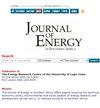Solid fuel use in electrified low-income residential areas in South Africa: The case of KwaDela, Mpumalanga
IF 0.6
4区 工程技术
Q4 ENERGY & FUELS
引用次数: 1
Abstract
Domestic solid fuel combustion remains a key contributor to indoor and ambient air pollution in low-income settlements. Understanding solid-fuel cost perceptions and burning patterns variability is required for developing sustainable energy policies and applicable site-specific intervention strategies to effectively improve ambient air quality. The purpose of the study was to understand domestic solid fuel use dynamics and trends in KwaDela, a low-income residential area in Mpumalanga. Data were gathered using surveys, questionnaires, observations, and temperature sensors. Findings were that there are two main local sources of wood and coal within the settlement and each household was estimated to consume 1 800 to 2 992.5 kg of coal annually. The maximum amount of coal used per burning event was 9.3 kg, with an average of 4 kg and a standard deviation of ±2.5 kg. Coal and wood purchase price varied depending on their sources, but were cheaper than electricity. In winter, the burning events are longer (four to six hours) than in summer and more (one to three) per day, and start earlier (from 03:00 and 15:30) mainly due to space-heating needs. Cooking, space-heating and boiling water are the major household needs that drive the use of solid fuels in electrified low-income residential areas. The key to improving air quality in such areas is integrating fuel use intervention methods that the residents can afford and are readily accessible.南非低收入电气化住宅区固体燃料的使用:以普马兰加省夸德拉为例
家庭固体燃料燃烧仍然是造成低收入住区室内和环境空气污染的一个主要因素。了解固体燃料的成本观念和燃烧模式的可变性是制定可持续能源政策和适用的特定地点干预策略以有效改善环境空气质量所必需的。这项研究的目的是了解普马兰加省低收入居民区夸德拉的国内固体燃料使用动态和趋势。通过调查、问卷、观察和温度传感器收集数据。调查结果显示,该定居点有两种主要的当地木材和煤炭来源,估计每户每年消耗1 800至2 992.5公斤煤炭。每个燃烧事件的最大用煤量为9.3公斤,平均值为4公斤,标准差为±2.5公斤。煤炭和木材的购买价格因其来源而异,但比电力便宜。在冬季,燃烧事件比夏季更长(4至6小时),每天更多(1至3次),并且开始时间更早(从03:00到15:30),主要是由于空间供暖需求。在电气化的低收入住宅区,烹饪、空间供暖和开水是推动固体燃料使用的主要家庭需求。改善这些地区空气质量的关键是整合居民负担得起且容易获得的燃料使用干预方法。
本文章由计算机程序翻译,如有差异,请以英文原文为准。
求助全文
约1分钟内获得全文
求助全文
来源期刊

Journal of Energy in Southern Africa
ENERGY & FUELS-
CiteScore
3.00
自引率
0.00%
发文量
16
审稿时长
6 months
期刊介绍:
The journal has a regional focus on southern Africa. Manuscripts that are accepted for consideration to publish in the journal must address energy issues in southern Africa or have a clear component relevant to southern Africa, including research that was set-up or designed in the region. The southern African region is considered to be constituted by the following fifteen (15) countries: Angola, Botswana, Democratic Republic of Congo, Lesotho, Malawi, Madagascar, Mauritius, Mozambique, Namibia, Seychelles, South Africa, Swaziland, Tanzania, Zambia and Zimbabwe.
Within this broad field of energy research, topics of particular interest include energy efficiency, modelling, renewable energy, poverty, sustainable development, climate change mitigation, energy security, energy policy, energy governance, markets, technology and innovation.
 求助内容:
求助内容: 应助结果提醒方式:
应助结果提醒方式:


